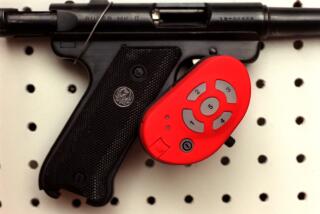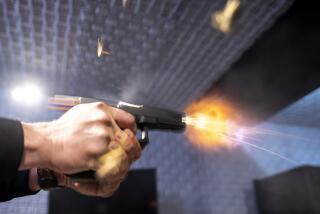Types of Gun Security Devices
- Share via
Gun security devices can be categorized two ways: by complexity and by price, with complexity defined as some sort of locking device--whether it be with a key or with a combination lock.
While space does not permit a complete review of all the different types of locking mechanisms, we will look at the most common types available at sporting goods stores and gun shops. We’ll start with the most inexpensive.
A gun case and a padlock.
A simple and inexpensive way to keep a gun away from a small child is by placing the gun into a gun case, then securing it closed and locked with a padlock. Gun cases vary in price and come in two basic types: soft and hard.
Soft cases are usually made out of fabric or leather and use a metal zipper to enclose the case around the gun. Prices for fabric cases start around $15. For the soft case, a small padlock links the zipper to a metal ring usually found at the base of the zipper when it is closed. A fabric case is a reasonably secure way to safeguard a gun against children up to 5 or 6 years old.
However, experts say, after the child reaches the age where he or she has the dexterity to handle a knife or a sharp pair of scissors, and possibly cut into a fabric case and gain access to the gun, a hard gun case may be the better choice.
Hard cases are made of either plastic or metal. Most hard-plastic gun cases open like a clam shell. A common design for plastic cases has sliding tabs that secure two sides together. These cases have holes next to the tabs when they are in the closed position. Small padlocks then slide into the holes and secure the tabs from being opened.
A hard-plastic case can run under $7. A small padlock will run under $2. So, for under $10, you can keep a small child from gaining access to a handgun. Hard and soft cases are available for long guns such as rifles and shotguns.
Key-locking devices.
Another product that has gained popularity is a trigger locking device. Made up of two metal pieces, the device fits around the trigger and the trigger guard, and is secured with a key lock. One of the benefits with the trigger lock is that it is almost universal. It can be used on a handgun, rifle or shotgun, but not on a lever-activated rifle. Prices for a key-locking trigger guard run about $15.
At least one manufacturer offers a trigger guard that fastens the two pieces together with a screw rather than a key lock. The screw is turned into the unit with a two-pronged screwdriver, not a standard blade or Phillips screwdriver. Price is under $10.
Next in line both in price and complexity is the locking gun case. Basically, this is a metal gun case with a locking unit built into it. Usually two duplicate keys come with the unit, and prices start around $30. Locking hard cases are available for both handguns and long guns. With some units, the securing clasp also contains the lock, much as you would find on a suitcase.
Another style is the sheet metal gun box. These units fall somewhere between the gun cases just mentioned and gun safes. Usually they are made from heavy gauge sheet metal, and the door to the gun box is secured by a smooth, round-faced lock that’s harder to break open than a padlock. The bottom of the box is usually pre-drilled so it can be bolted to the floor or to a piece of furniture.
Because of the construction, someone would need to use something like a heavy pry bar to force open the door, experts say. This unit is designed to keep a gun secure from thieves who only want to break into a home, quickly grab what they can and then leave in a hurry. These units run about $40.
Combination locking devices.
Quick access to a loaded gun is very important for some owners. Because of that, cases that lock with a key can be a problem.
One of the types of locking gun cases proving to be very popular, Harris said, is the combination lock case. Rather than turn a dial, as with traditional safes, the combination lock gun case has a series of buttons to push. Unless the proper sequence is pushed, the case won’t open. Prices run about $70.
Many of these models also offer pre-drilled holes to allow the case to be bolted to furniture or the floor. Again, this design is available for handguns as well as long guns. There are even wall units that can be hidden by framed paintings.
Gun safes.
The traditional securing device has been the gun safe. Much like the old safes you might see in a Western movie, these are free-standing, can weigh hundreds of pounds and are made of thick steel, usually with dial combination locks.
Quick access is not a high priority; security is. A petty thief most likely would not be able to gain entry. Some are even rated for the ability to withstand fire.
Sizes vary from perhaps two feet by two feet, to five or six feet high, and the taller versions can hold several long guns as well as handguns. Some are painted in detail, and can be decorative. Prices start around $100, but many are in the $500 to $2,000 range.
Non-locking devices.
Many of these devices either wrap around part of the gun, stick into the barrel or block a key part, such as the breech.
One design, the Strap Lock, is like a big rubber band. A plastic piece attached to the front of the band extends into the barrel, while the other end is pulled over the rear part of the gun and fits over the hammer.
The basic premise is that a child is not strong enough to pull the rubber band-like Strap Lock off the gun. Even an adult needs to exert pressure to remove the strap. It sells for about $20.


